Excerpted with permission from Building Business Solutions: Business Analysis with Business Rules, by Ronald G. Ross with Gladys S.W. Lam, An IIBA® Sponsored Handbook, Business Rule Solutions, LLC, October, 2011, 304 pp, http://www.brsolutions.com/bbs
Before harvesting business rules, you should be aware of some basic principles and absorb them into your practices.
First, all business rules are subject to change, including (and perhaps especially) business rules derived directly from business policies. The ability to change and redeploy business rules is essential to business agility.
Basic Principle for Business Rules: No business rule is ever set in stone
Aside: Across industries, we’ve found that typically only 30-45% of all business rules change rapidly. Some of those though change quite rapidly.
A business rule must make sense for all stakeholders, business tasks, and operational business events within scope.
The resulting mindset is quite different from traditional requirements methodologies. In those approaches, especially ones centered on use cases, the focus is local to individual roles and interactions. The issues of business agility, compliance, and know-how, however, are global for the scope.
Basic Principle for Business Rules: A business rule must make global sense across architectural scope.
There is no such thing as an implicit business rule in any business model. Assuming that other people share intuitive understanding about some unexpressed business rule(s) usually leads to big trouble downstream. We like to say that if a business rule isn’t explicit it doesn’t exist.
Basic Principle for Business Rules: There are no business rules until you say there are.
Making business rules explicit puts a premium on the words you use to express them. Sooner or later you’ll find you need a structured business vocabulary – a fact model.
Business Rules vs. Choices Made in Designing Systems:
Not the Same Thing!
A colleague and I were recently discussing business rules. In the course of conversation he used this example: A customer may have only one address.
Hold on! That’s not a business rule. Rather, it’s a design decision (probably a poor one) some IT person made in creating a system model. The business wouldn’t (and couldn’t!) make a real-world business rule about customers having only one address. But a design decision might be made to record only one (in a system).
Eventually we agreed the desired business rule probably was: A customer may have only one preferred address.
Expressing Business Rules
A fact model defines shared business concepts. The meaning of these concepts is given by definitions. When you look at a fact model you should see a structured business vocabulary that includes both nouns (terms) and verbs (wordings). These nouns and verbs are used directly in expressing business rules.
Sample business rule: A customer must be assigned to an agent if the customer has placed an order.
The relevant terms and wordings for this sample business rule are shown in Figure 1.
The relevant terms and wordings for this sample business rule are shown in Figure 1.

The sample business rule directly uses the fact types worded customer places order and customer is assigned to agent, with only minor adjustments in tense as appropriate for English grammar. As this example illustrates, every business rule can be expressed as a complete sentence that includes a sense of obligation or necessity for relevant fact types.
Business capabilities often involve hundreds or even thousands of business rules. Achieving consistency and coherence across so many business rules requires a blueprint. A structured business vocabulary (fact model) is indispensable for scaling up.
Aside: Basing verbalizations directly on wordings for fact types is a key feature of business-oriented notations for business rules such as RuleSpeak. See www.RuleSpeak.com (free).
Are Your Legacy Business Rules Right?
A Business Analyst at a major insurance company recently said this:
“When we looked hard at business rules currently implemented in existing systems, we found at least 30% were flatly wrong. That’s a very conservative estimate: the actual figure was probably much higher. IT told us they couldn’t solve the problem because it was a business issue not a software issue. And they were absolutely right about that.”
The thing about business rules is you never know who will read them or what background or purpose the reader may have. So every business rule (including ‘exceptions’) must be understandable out of context. The words you use must have clear definitions; the expression must include everything needed to interpret it correctly.
Basic Principle for Business Rules: A business rule means exactly what the words you use to express it mean – nothing more and nothing less
Turning Business Policies into Core Business Rules
A business policy is guidance representing a critical do or don’t in day-to-day operation of a business capability. The ongoing success of a business capability is largely determined by its business policies.
A core business rule is a business rule derived directly from a business policy. Like the business policy on which it is based, it too is make-or-break for the business capability.
Aside: We estimate that only 2-3% of all business rules are derived
directly from business policies crucial to the strategy for the business
solution. These select business rules should be crafted and managed
with extra-special care.
Think of a business policy as some business rule(s) in the making. A business policy always provides guidance, but rarely in a form ready to deploy to business people or machines. Additional analysis and refinement is required first.
Sample business policy: Pizzas should be delivered within one hour.
A Business Analyst should ask:
Basic Principle for Business Rules: A business rule is always practicable.
Business policies fail the practicable test. The standard for business strategy, the Business Motivation Model[1] , compares a business policy to a business rule as follows: A business policy tends to be less structured, less discrete, less atomic, less compliant with standard business vocabulary, and less formally articulated.
Example: The core business rule derived from the one-hour pizza delivery policy might be: A pizza order delivered off-premises must be handed-off to the customer within one hour from the time the pizza order is taken.
Use Your Time with Business Leads Wisely
Business leads usually have only limited time to review business rules, so use their time wisely. In addition to core business rules, pay special attention to business rules that:
• Address compliance with law, regulations, etc.
• Enforce contracts, agreements, and deals
• Maintain appropriate or desired quality of service
• Define escalation criteria (service level agreements)
• Establish business priorities
• Reflect business culture or philosophy
• Improve (or lower) productivity significantly
• Ensure operational business activity remains within supportable limits
General Pattern Questions for Harvesting Business Rules
Basic business rules can be captured from many sources using the general pattern questions presented below. These pattern questions focus directly on the basic engineering questions what, how, where, who, when, and why, plus exceptions. Applying these pattern questions represents an important step in externalizing semantics from other parts of a business model, especially business process models.
Aside: Other pattern questions focus selectively and specifically on business process models, fact model, etc.
General Pattern Question for ‘What’

General Pattern Question for ‘What’
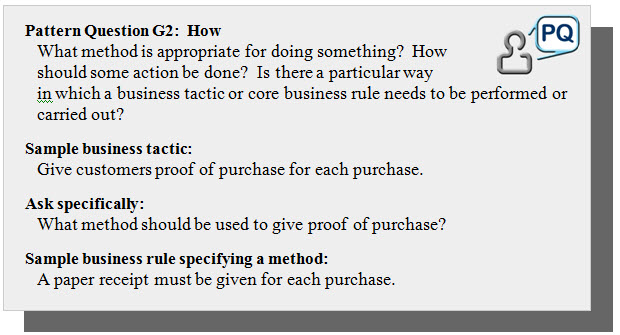
General Pattern Question for ‘Where’
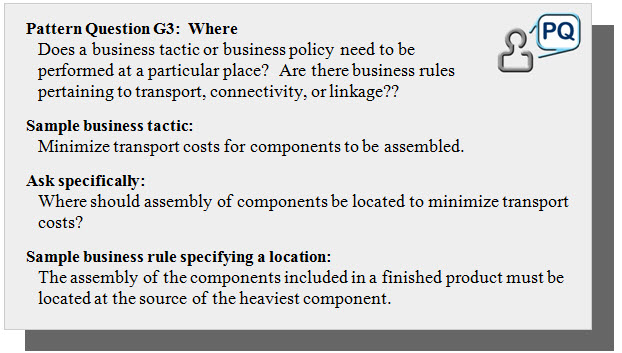
General Pattern Question for ‘Who’
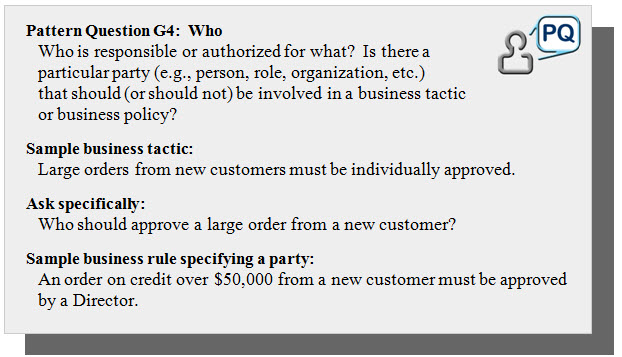
General Pattern Question for ‘When’
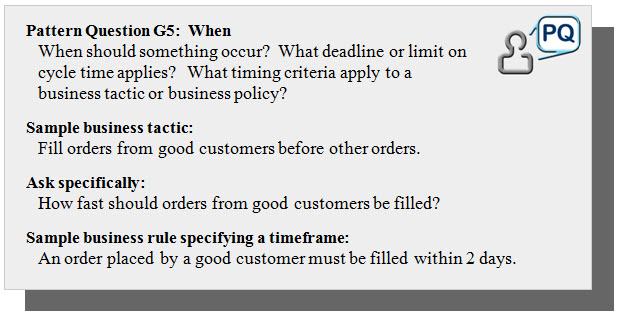
General Pattern Question for ‘Why’

General Pattern Question for Exceptions
Aside: ‘Exceptions’ to business rules simply imply more business rules.
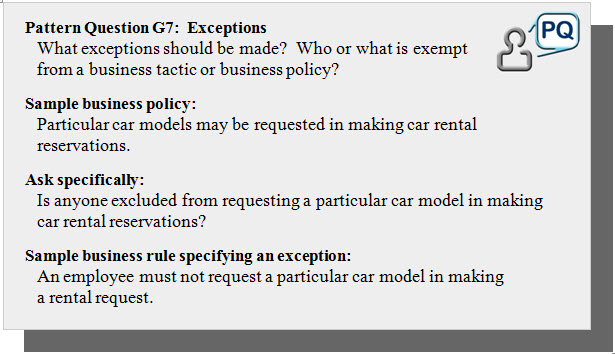
Summary
Business rules offer a powerful tool for Business Analysts to improve communication with business leads (and IT) and to come to grips with real-life complexity. The basic principles and techniques of business rules are relatively straightforward. It’s all a matter of getting started and then practice, practice, practice.
About the authors
 Ronald G. Ross is recognized internationally as the ‘father of business rules.’ He is Co-founder and Principal of Business Rule Solutions, LLC, where he is active in consulting services, publications, the Proteus® methodology, and RuleSpeak®. Mr. Ross serves as Executive Editor of BRCommunity.com and as Chair of the Business Rules Forum Conference. He is the author of eight professional books, most recently Business Rule Concepts (2009). Mr. Ross speaks and gives popular public seminars across the globe. His blog: http://www.ronross.info/blog/
Ronald G. Ross is recognized internationally as the ‘father of business rules.’ He is Co-founder and Principal of Business Rule Solutions, LLC, where he is active in consulting services, publications, the Proteus® methodology, and RuleSpeak®. Mr. Ross serves as Executive Editor of BRCommunity.com and as Chair of the Business Rules Forum Conference. He is the author of eight professional books, most recently Business Rule Concepts (2009). Mr. Ross speaks and gives popular public seminars across the globe. His blog: http://www.ronross.info/blog/
 Gladys S.W. Lam is a world-renowned authority on business analysis and applied business rule techniques. She is Co-founder and Principal of Business Rule Solutions, LLC, the most recognized company world-wide for business rule methodology, consulting services, and training. Ms. Lam serves as Publisher of BRCommunity.com and as Executive Director of the Building Business Capabilities Conference. She is a recognized expert on project management and is highly active in consulting, mentoring, and training.
Gladys S.W. Lam is a world-renowned authority on business analysis and applied business rule techniques. She is Co-founder and Principal of Business Rule Solutions, LLC, the most recognized company world-wide for business rule methodology, consulting services, and training. Ms. Lam serves as Publisher of BRCommunity.com and as Executive Director of the Building Business Capabilities Conference. She is a recognized expert on project management and is highly active in consulting, mentoring, and training.
[1]Business Rules Group. [May 2010]. The Business Motivation Model (BMM) ~ Business Governance in a Volatile World (Version 1.4). Available at: http://www.BusinessRulesGroup.org Originally published as Organizing Business Plans ~ The Standard Model for Business Rule Motivation (Nov. 2000). Now an adopted standard of the Object Management Group (OMG).